Abstract
The lethal toxin of Bacillus anthracis consists of two components, protective antigen and lethal factor. Protective antigen is cleaved after binding to cell receptors, yielding a receptor-bound fragment that binds lethal factor. Sixty-one monoclonal antibodies to the lethal factor protein have been characterized for specificity, antibody subtype, and ability to neutralize lethal toxin. Three monoclonal antibodies (10G3, 2E7, and 3F6) neutralized lethal toxin in Fisher 344 rats. However, in a macrophage cytolysis assay, monoclonal antibodies 10G3, 2E7, 10G4, 10D4, 13D10, and 1D8, but not 3F6, were found to neutralize lethal toxin. Binding studies showed that five of the monoclonal antibodies that neutralized lethal toxin in the macrophage assay (10G3, 2E7, 10G4, 10D4, and 13D10) did so by inhibiting the binding of lethal factor to the protective antigen fragment bound to cells. Monoclonal antibody 1D8, which was also able to neutralize lethal toxin activity after lethal factor was prebound to cell-bound protective antigen, only partially inhibited binding of lethal factor to protective antigen. Monoclonal antibody 3F6 did not inhibit the binding of lethal factor to protective antigen. A competitive-binding enzyme-linked immunosorbent assay showed that at least four different antigenic regions on lethal factor were recognized by these seven neutralizing hybridomas. The anomalous behavior of 3F6 suggests that it may induce a conformational change in lethal factor. Differences in neutralizing activity of monoclonal antibodies were related to their relative affinity and epitope specificity and the type of assay.
Full text
PDF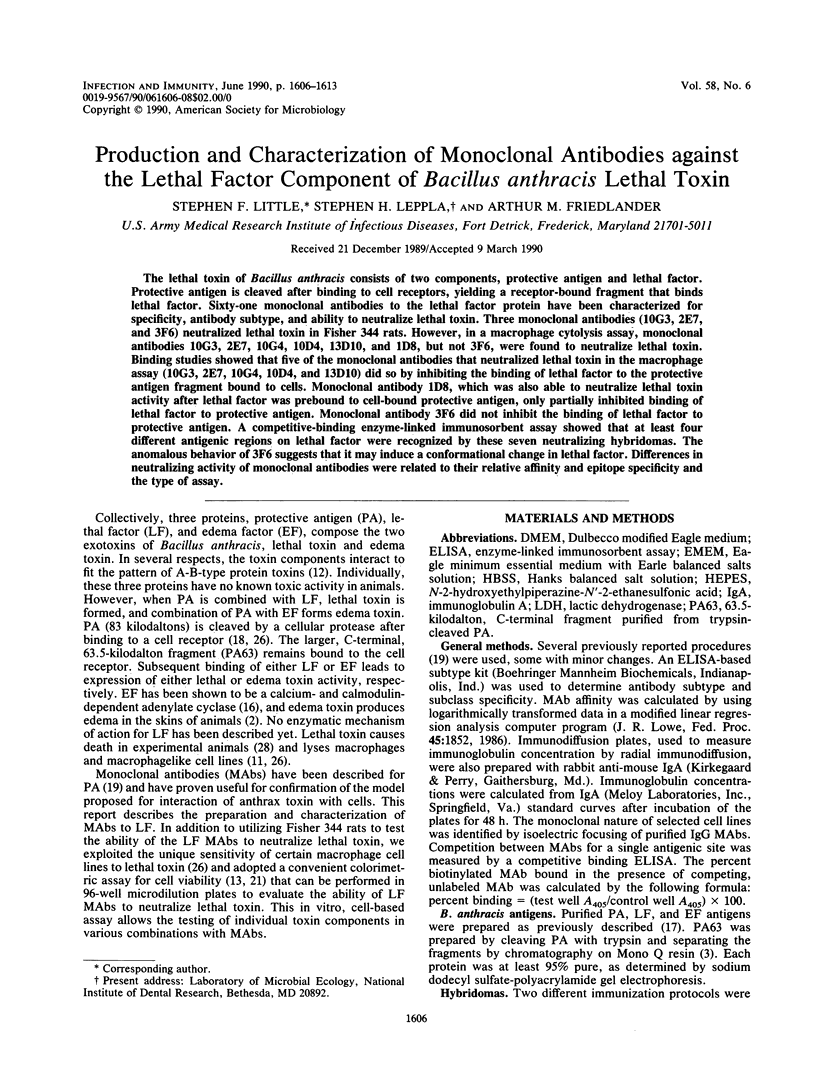
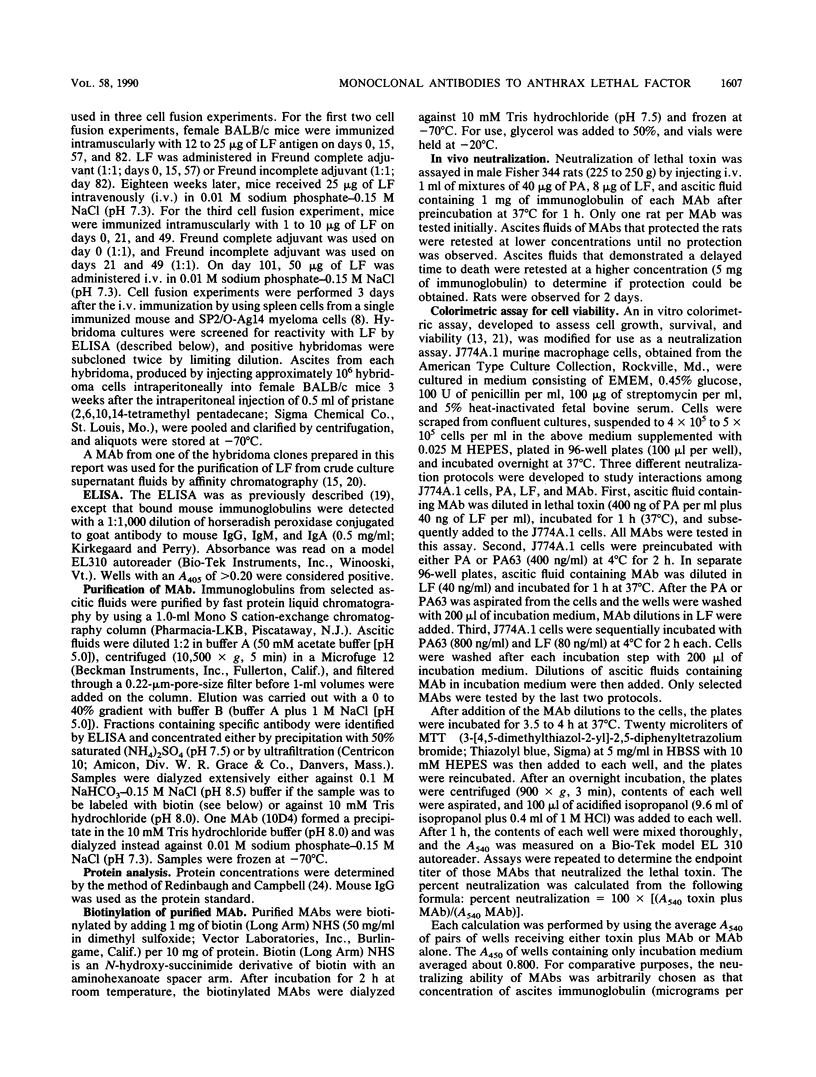
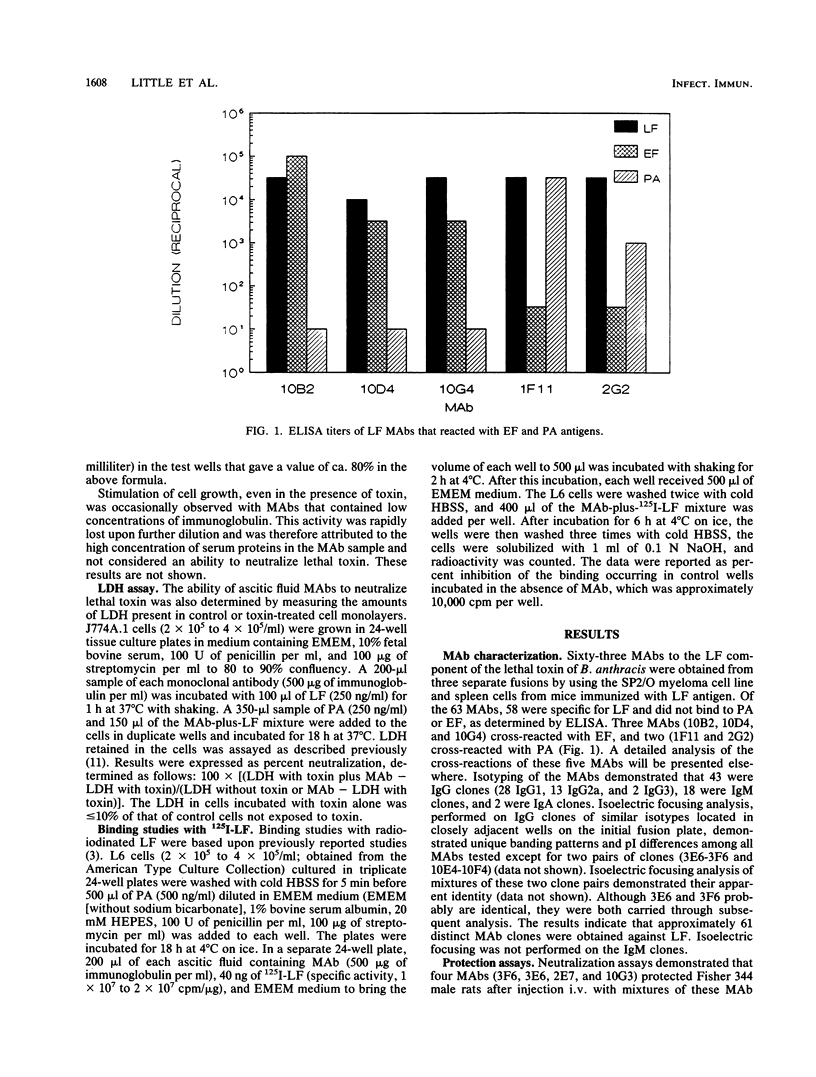
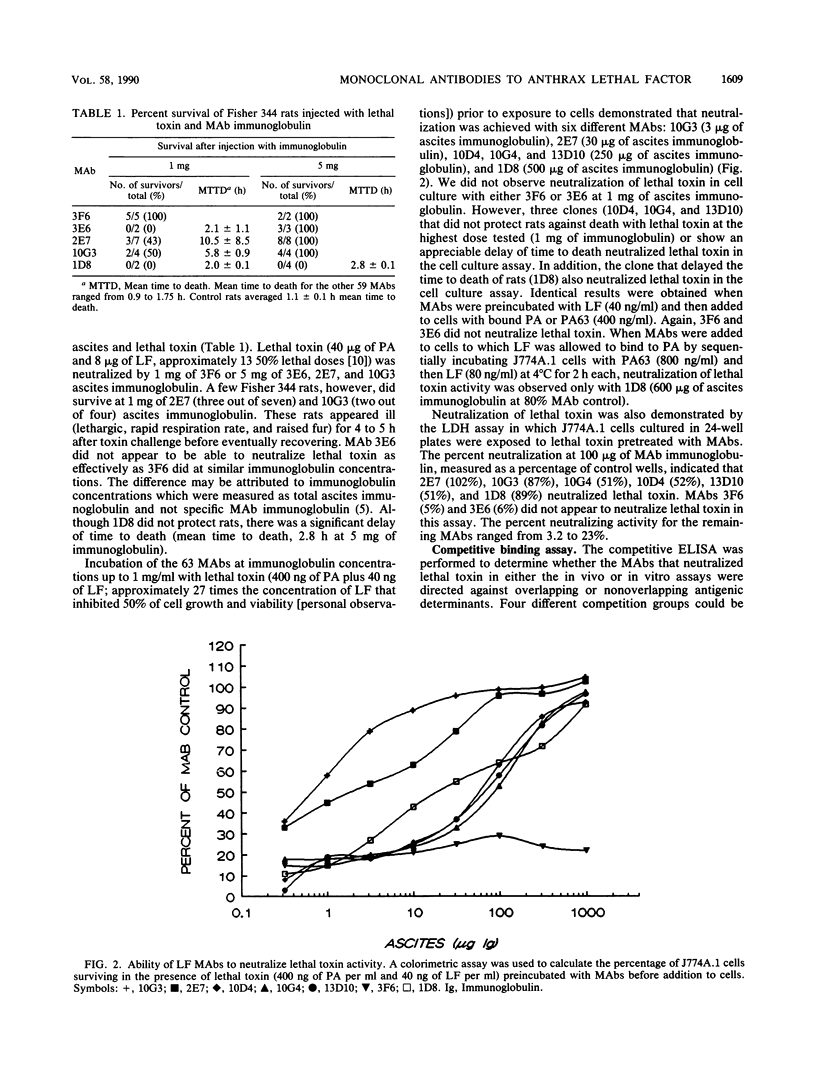
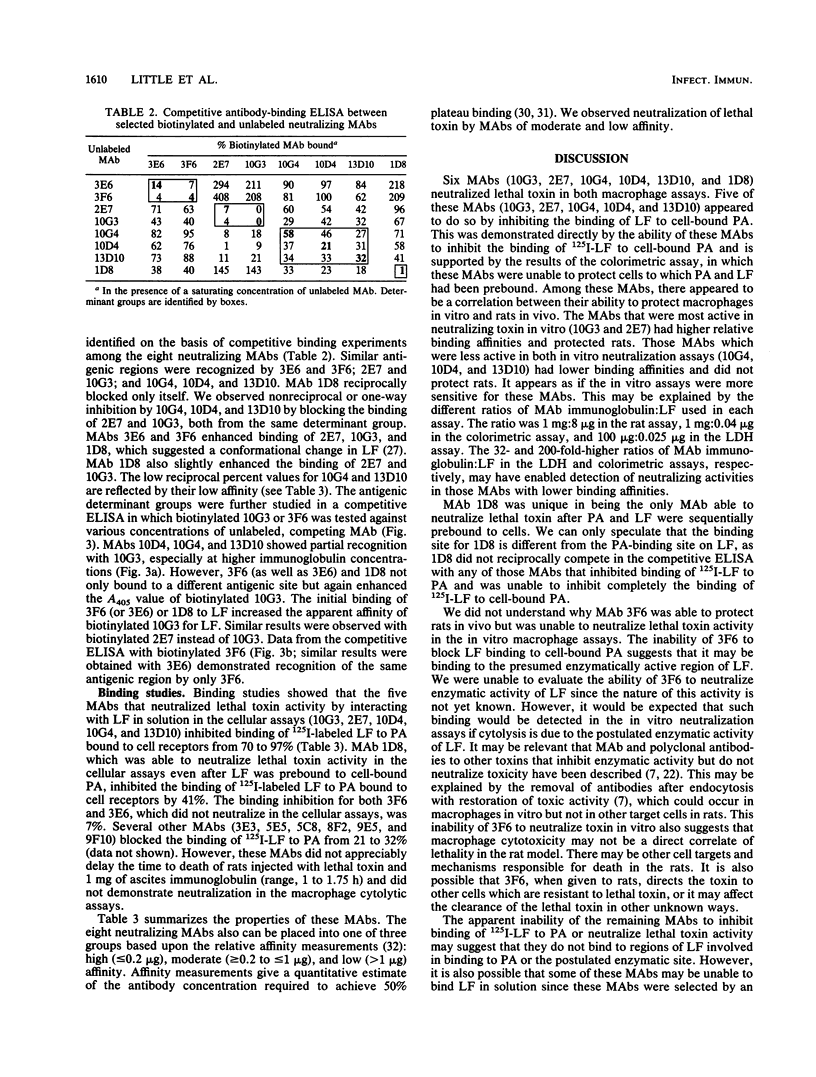
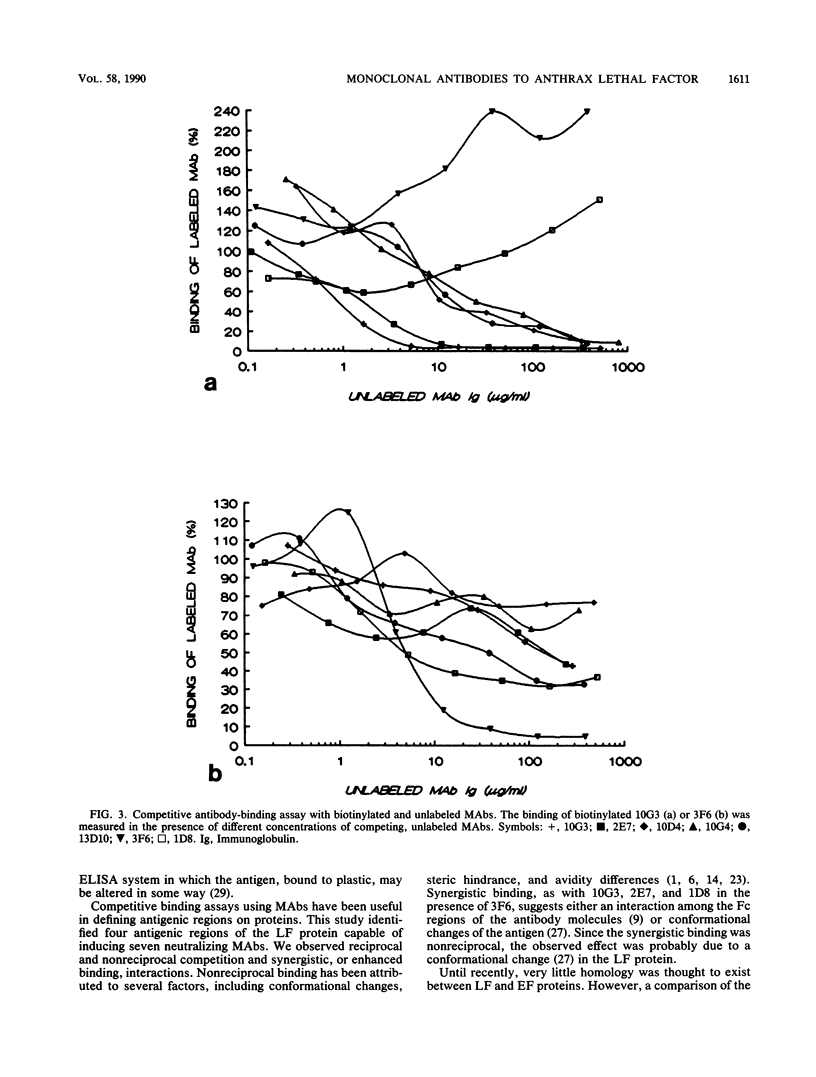
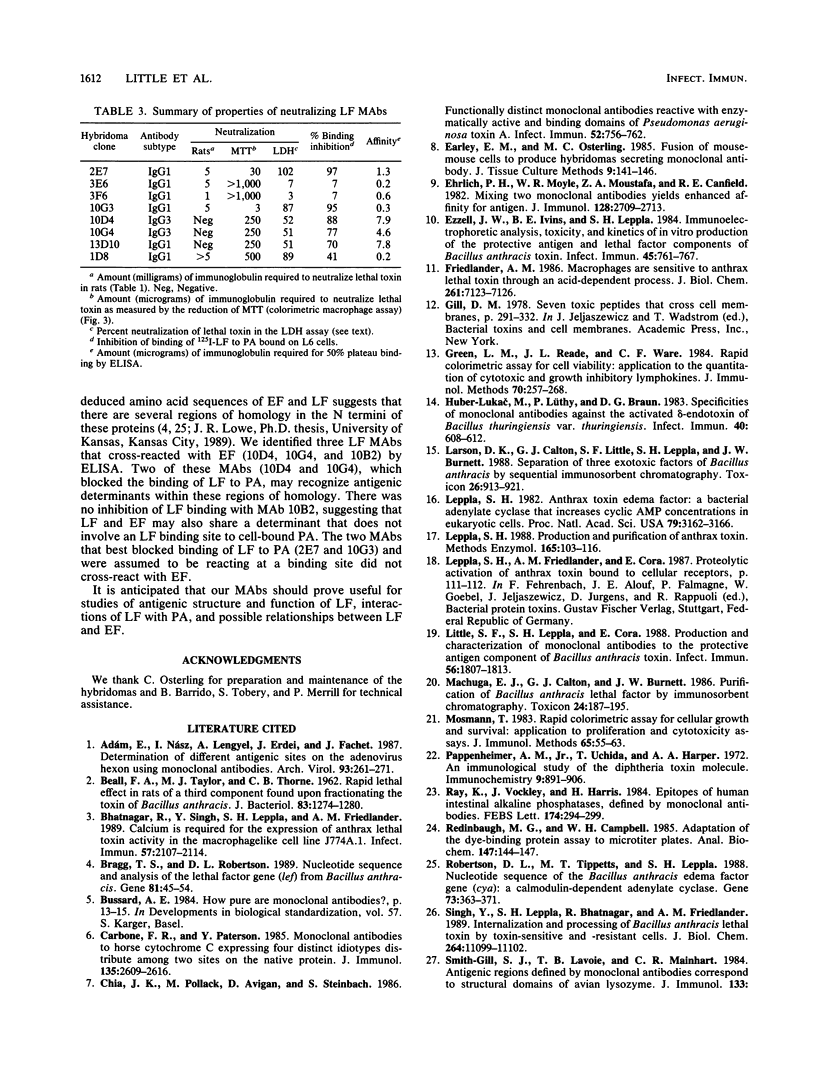
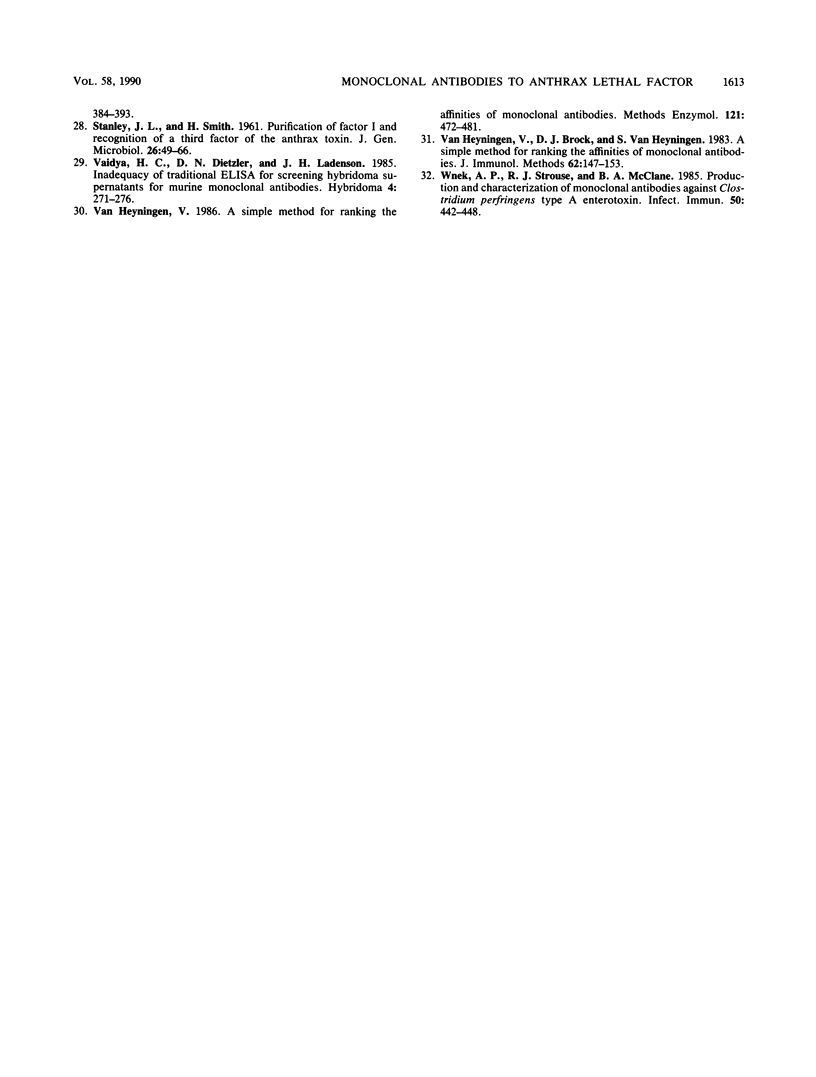
Selected References
These references are in PubMed. This may not be the complete list of references from this article.
- Adám E., Nász I., Lengyel A., Erdei J., Fachet J. Determination of different antigenic sites on the adenovirus hexon using monoclonal antibodies. Arch Virol. 1987;93(3-4):261–271. doi: 10.1007/BF01310979. [DOI] [PMC free article] [PubMed] [Google Scholar]
- BEALL F. A., TAYLOR M. J., THORNE C. B. Rapid lethal effect in rats of a third component found upon fractionating the toxin of Bacillus anthracis. J Bacteriol. 1962 Jun;83:1274–1280. doi: 10.1128/jb.83.6.1274-1280.1962. [DOI] [PMC free article] [PubMed] [Google Scholar]
- Bhatnagar R., Singh Y., Leppla S. H., Friedlander A. M. Calcium is required for the expression of anthrax lethal toxin activity in the macrophagelike cell line J774A.1. Infect Immun. 1989 Jul;57(7):2107–2114. doi: 10.1128/iai.57.7.2107-2114.1989. [DOI] [PMC free article] [PubMed] [Google Scholar]
- Bragg T. S., Robertson D. L. Nucleotide sequence and analysis of the lethal factor gene (lef) from Bacillus anthracis. Gene. 1989 Sep 1;81(1):45–54. doi: 10.1016/0378-1119(89)90335-1. [DOI] [PubMed] [Google Scholar]
- Bussard A. E. How pure are monoclonal antibodies? Dev Biol Stand. 1984;57:13–15. [PubMed] [Google Scholar]
- Carbone F. R., Paterson Y. Monoclonal antibodies to horse cytochrome c expressing four distinct idiotypes distribute among two sites on the native protein. J Immunol. 1985 Oct;135(4):2609–2616. [PubMed] [Google Scholar]
- Chia J. K., Pollack M., Avigan D., Steinbach S. Functionally distinct monoclonal antibodies reactive with enzymatically active and binding domains of Pseudomonas aeruginosa toxin A. Infect Immun. 1986 Jun;52(3):756–762. doi: 10.1128/iai.52.3.756-762.1986. [DOI] [PMC free article] [PubMed] [Google Scholar]
- Ehrlich P. H., Moyle W. R., Moustafa Z. A., Canfield R. E. Mixing two monoclonal antibodies yields enhanced affinity for antigen. J Immunol. 1982 Jun;128(6):2709–2713. [PubMed] [Google Scholar]
- Ezzell J. W., Ivins B. E., Leppla S. H. Immunoelectrophoretic analysis, toxicity, and kinetics of in vitro production of the protective antigen and lethal factor components of Bacillus anthracis toxin. Infect Immun. 1984 Sep;45(3):761–767. doi: 10.1128/iai.45.3.761-767.1984. [DOI] [PMC free article] [PubMed] [Google Scholar]
- Friedlander A. M. Macrophages are sensitive to anthrax lethal toxin through an acid-dependent process. J Biol Chem. 1986 Jun 5;261(16):7123–7126. [PubMed] [Google Scholar]
- Green L. M., Reade J. L., Ware C. F. Rapid colorimetric assay for cell viability: application to the quantitation of cytotoxic and growth inhibitory lymphokines. J Immunol Methods. 1984 May 25;70(2):257–268. doi: 10.1016/0022-1759(84)90190-x. [DOI] [PubMed] [Google Scholar]
- Huber-Lukac M., Lüthy P., Braun D. G. Specificities of monoclonal antibodies against the activated delta-endotoxin of Bacillus thuringiensis var. thuringiensis. Infect Immun. 1983 May;40(2):608–612. doi: 10.1128/iai.40.2.608-612.1983. [DOI] [PMC free article] [PubMed] [Google Scholar]
- Larson D. K., Calton G. J., Little S. F., Leppla S. H., Burnett J. W. Separation of three exotoxic factors of Bacillus anthracis by sequential immunosorbent chromatography. Toxicon. 1988;26(10):913–921. doi: 10.1016/0041-0101(88)90256-5. [DOI] [PubMed] [Google Scholar]
- Leppla S. H. Anthrax toxin edema factor: a bacterial adenylate cyclase that increases cyclic AMP concentrations of eukaryotic cells. Proc Natl Acad Sci U S A. 1982 May;79(10):3162–3166. doi: 10.1073/pnas.79.10.3162. [DOI] [PMC free article] [PubMed] [Google Scholar]
- Leppla S. H. Production and purification of anthrax toxin. Methods Enzymol. 1988;165:103–116. doi: 10.1016/s0076-6879(88)65019-1. [DOI] [PubMed] [Google Scholar]
- Little S. F., Leppla S. H., Cora E. Production and characterization of monoclonal antibodies to the protective antigen component of Bacillus anthracis toxin. Infect Immun. 1988 Jul;56(7):1807–1813. doi: 10.1128/iai.56.7.1807-1813.1988. [DOI] [PMC free article] [PubMed] [Google Scholar]
- Machuga E. J., Calton G. J., Burnett J. W. Purification of Bacillus anthracis lethal factor by immunosorbent chromatography. Toxicon. 1986;24(2):187–195. doi: 10.1016/0041-0101(86)90121-2. [DOI] [PubMed] [Google Scholar]
- Mosmann T. Rapid colorimetric assay for cellular growth and survival: application to proliferation and cytotoxicity assays. J Immunol Methods. 1983 Dec 16;65(1-2):55–63. doi: 10.1016/0022-1759(83)90303-4. [DOI] [PubMed] [Google Scholar]
- Pappenheimer A. M., Jr, Uchida T., Harper A. A. An immunological study of the diphtheria toxin molecule. Immunochemistry. 1972 Sep;9(9):891–906. doi: 10.1016/0019-2791(72)90163-2. [DOI] [PubMed] [Google Scholar]
- Ray K., Vockley J., Harris H. Epitopes of human intestinal alkaline phosphatases, defined by monoclonal antibodies. FEBS Lett. 1984 Sep 3;174(2):294–299. doi: 10.1016/0014-5793(84)81176-x. [DOI] [PubMed] [Google Scholar]
- Redinbaugh M. G., Campbell W. H. Adaptation of the dye-binding protein assay to microtiter plates. Anal Biochem. 1985 May 15;147(1):144–147. doi: 10.1016/0003-2697(85)90020-x. [DOI] [PubMed] [Google Scholar]
- Robertson D. L., Tippetts M. T., Leppla S. H. Nucleotide sequence of the Bacillus anthracis edema factor gene (cya): a calmodulin-dependent adenylate cyclase. Gene. 1988 Dec 20;73(2):363–371. doi: 10.1016/0378-1119(88)90501-x. [DOI] [PubMed] [Google Scholar]
- STANLEY J. L., SMITH H. Purification of factor I and recognition of a third factor of the anthrax toxin. J Gen Microbiol. 1961 Sep;26:49–63. doi: 10.1099/00221287-26-1-49. [DOI] [PubMed] [Google Scholar]
- Singh Y., Leppla S. H., Bhatnagar R., Friedlander A. M. Internalization and processing of Bacillus anthracis lethal toxin by toxin-sensitive and -resistant cells. J Biol Chem. 1989 Jul 5;264(19):11099–11102. [PubMed] [Google Scholar]
- Vaidya H. C., Dietzler D. N., Ladenson J. H. Inadequacy of traditional ELISA for screening hybridoma supernatants for murine monoclonal antibodies. Hybridoma. 1985 Fall;4(3):271–276. doi: 10.1089/hyb.1985.4.271. [DOI] [PubMed] [Google Scholar]
- Van Heyningen V., Brock D. J., Van Heyningen S. A simple method for ranking the affinities of monoclonal antibodies. J Immunol Methods. 1983 Aug 26;62(2):147–153. doi: 10.1016/0022-1759(83)90000-5. [DOI] [PubMed] [Google Scholar]
- Wnek A. P., Strouse R. J., McClane B. A. Production and characterization of monoclonal antibodies against Clostridium perfringens type A enterotoxin. Infect Immun. 1985 Nov;50(2):442–448. doi: 10.1128/iai.50.2.442-448.1985. [DOI] [PMC free article] [PubMed] [Google Scholar]
- van Heyningen V. A simple method for ranking the affinities of monoclonal antibodies. Methods Enzymol. 1986;121:472–481. doi: 10.1016/0076-6879(86)21046-0. [DOI] [PubMed] [Google Scholar]


